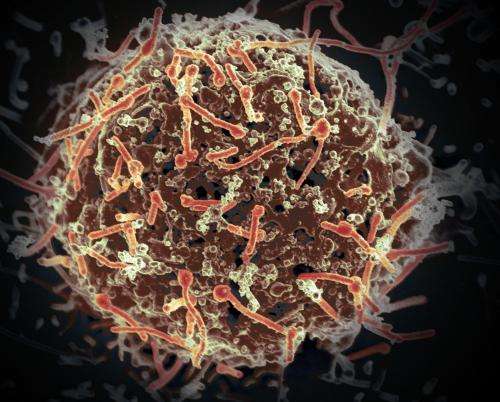

The Ebola virus, isolated in November 2014 from patient blood samples obtained in Mali. The virus was isolated on Vero cells in a BSL-4 suite at Rocky Mountain Laboratories. Credit: NIAID
A new Ebola test that uses magnetic nanoparticles could help curb the spread of the disease in western Africa. Research published in Biosensors and Bioelectronics shows that the new test is 100 times more sensitive than the current test, and easier to use. Because of this, the new test makes it easier and cheaper to diagnose cases, enabling healthcare workers to isolate patients and prevent the spread of Ebola.
The authors of the study, from the Chinese Academy of Sciences, say their new technology could be applied to the detection of any biological molecules, making it useful to diagnose other infectious diseases, like flu, and potentially detect tumors and even contamination in wastewater.
The Ebola virus causes an acute illness that is deadly in half of all cases, on average. The current outbreak of Ebola, which started in March 2014, affects countries in west Africa. In the most severely affected countries, like Guinea, Liberia and Sierra Leone, resources are limited, making control of the outbreak challenging. There is no vaccine for Ebola, so detecting the virus is key to controlling the outbreak: with an accurate diagnosis, patients can be isolated and treated properly, reducing the risk of spread.
"In west Africa, resources are under pressure, so complicated, expensive tests are not very helpful," said Professor Xiyun Yan, one of the authors of the study from the Chinese Academy of Sciences. "Our new strip test is a simple, one-step test that is cheap and easy to use, and provides a visible signal, which means people don't need training to use it. We think it will be especially helpful in rural areas, where technical equipment and skills are not available."
Currently there are two ways to test for the Ebola virus: using a method called polymerase chain reaction (PCR), which makes copies of the molecules for detection, and with antibody-capture enzyme-linked immunosorbent assay (ELISA), which gives a visual indication when a given molecule is in a sample. PCR is very sensitive, but is expensive and complicated, requiring special skills and technical equipment. The ELISA - or gold strip test - is cheaper but sensitivity is very low, which means it often gives the wrong results.
The new test, called the nanozyme test, uses magnetic nanoparticles, which work like enzymes to make the signal stronger, giving a clearer result you can see with the naked eye. The test can detect much smaller amounts of the virus, and is 100 times more sensitive than the gold strip test.
"People have loved the strip test for many years, but it has a major weakness: it's not sensitive enough. We're very excited about our new nanozyme test, as it is much more sensitive and you don't need any specialist equipment to get a quick, accurate result," said Dr. Yan.
Strip tests work by attaching molecules called antibodies to gold particles to look for a particular molecule in a sample. When they attach to the molecule you're looking for, in this case a virus, they produce a signal, such as a color change. In order to find the virus, the particles need to be labelled with enzymes, which speed up detection and signalling.
With the new nanozyme test, the researchers applied magnetic nanoparticles as a nanozyme probe in place of gold nanoparticles. After labeling with an antibody that attaches to the Ebola virus, this novel probe is able to recognize and separate the virus in a sample. The nanoparticles are magnetic, so to concentrate the virus particles in a sample, all you need to do is hold the sample against a magnet; no expensive equipment is needed.
The nanozyme test is 100 times more sensitive than the gold strip test, detecting molecules called glycoproteins on the surface of the Ebola virus at concentrations as low as 1 nanogram per milliliter.
The researchers have applied for a patent for the new test, which is currently being taken to west Africa by the CDC to use in the field. The researchers are also collaborating with clinical teams to apply the technology to other diseases, and with a company that treats wastewater to see if it can help remove environmental contamination. (Medical Press)

86-10-68597521 (day)
86-10-68597289 (night)

86-10-68511095 (day)
86-10-68512458 (night)

cas_en@cas.cn

52 Sanlihe Rd., Xicheng District,
Beijing, China (100864)

